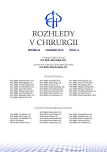Urgent surgical treatment of gastric volvulus related to upside-down stomach syndrome
Authors:
L. Hána 1; M. Kasalický 1; E. Koblihová 1; Š. Suchánek 2; P. Horažďovský 3; M. Ryska 1
Authors place of work:
Chirurgická klinika 2. LF Univerzity Karlovy a ÚVN, Praha
přednosta: prof. MUDr. M. Ryska, CSc.
1; Oddělení gastrointestinální endoskopie, Interní klinika 1. LF Univerzity Karlovy a ÚVN - Vojenská fakultní nemocnice Praha
přednosta: prof. MUDr. M. Zavoral, Ph. D.
2; Oddělení hrudní chirurgie, Thomayerova nemocnice Praha
primář: MUDr. V. Hytych, Ph. D.
3
Published in the journal:
Rozhl. Chir., 2015, roč. 94, č. 12, s. 531-534.
Category:
Kazuistika
Summary
Upside-down stomach syndrome is a rare type of a large paraoesophageal hiatal hernia, which requires an immediate surgical treatment in case of incarceration. The authors present a case report of a 53-year-old male patient with gastric volvulus related to the upside-down stomach syndrome. Surgical treatment was complicated by an injury to distal oesophagus, which was successfully treated using a self-expandable metallic stent among other methods. Despite the complicated postoperative course with a necessity of reoperation, insertion of an oesophageal stent, thoracotomy for a mediastinal abscess and secondary healing of the laparotomy, the patient was discharged in a good condition with healed oesophageal perforation and laparotomy after 52 days.
Key words:
hiatal hernia – upside-down stomach syndrome – self-expandable metallic stent (SEMS)
Zdroje
1. Wolf BS, Brahms SA, Khilnani MT. The incidence of hiatal hernia in barium meal examination. J Mount Sinai Hosp N. Y. 1959;26 : 598.
2. Stylopoulos N, Rattner DW. The history of hiatal hernia Surgery. Ann Surg 2015;241 : 185−93.
3. Spechler SJ. Epidemiology and natural history of gastro-esophageal reflux disease. Digestion 1992;51 : 24−9.
4. Lukáš K. Refluxní choroba jícnu. Praha, Karolinum 2003.
5. Dyer NH, Pridie RB. Incidence of hiatus hernia in asymptomatic subjects. Gut 1968;9 : 696−9.
6. Schiergens TS, Thomas MN, Hüttl TP, et al. Management of acute upside-down stomach. BMC Surg 2013;13 : 55.
7. Nissen R, Rossetti M. Die Behandlung der Hiatushernien und Reflux-Oesophagitis mit Gastropexie und Fundoplicatio. Stuttgart, G. Thieme 1959.
8. Chau B, Dufel S. Gastric volvulus. Emerg Med J 2007;24 : 446−7.
9. Skinner DB, Belsey RH. Surgical management of esophageal reflux and hiatus hernia. J Thorac Cardiovasc Surg 1967; 53 : 33−54.
10. Allen MS, Trastek VF, Deschamps C, et al. Intrathoracic stomach: presentation and results of operation. J Thorac Cardiovasc Surg 1993;105 : 253−9.
11. Frazzoni M, Piccoli M, Conigliaro R, et al. Laparoscopic fundoplication for gastroesophageal reflux disease. World J Gastroenterol 2014;20 : 14272–9.
12. Raimondo D, Sinagra E, Facella T, et al. Self-expandable metal stent placement for closure of a leak after total gastrectomy for gastric cancer: report on three cases and review of the literature. Case Rep Gastrointest Med 2014;2014 : 5 pages.
13. Dasari BV, Neely D, Kennedy A, et al. The role of esophageal stents in the management of esophageal anastomotic leaks and benign esophageal perforations. Ann Surg 2014;259 : 852−60.
14. Inbar R, Santo E, Subchi Ael A, et al. Insertion of removable self-expanding metal stents as a treatment for postoperative leaks and perforations of the esophagus and stomach. Isr Med Assoc J 2011;13 : 230−3.
15. Freeman RK, Ascioti AJ, Dake M, et al. Assessment of the optimal time for removal of esophageal stents used in the treatment of an esophageal anastomotic leak or perforation. Ann Thorac Surg 2015 Aug;100 : 422−8.
16. Vrba R, Aujesky R, Vomackova K, et al. Upside-down stomach – results of mini-invasive surgical therapy. Videosurgery and other Miniinvasive Techniques. 2011;6 : 231−5.
17. Patel AD, Lin E, Lytle NW, et al. Combining laparoscopic giant paraesophageal hernia repair with sleeve gastrectomy in the obese patients. Surg Endosc 2015; 29 : 1115−22.
Štítky
Chirurgie všeobecná Ortopedie Urgentní medicínaČlánek vyšel v časopise
Rozhledy v chirurgii

2015 Číslo 12
- Metamizol jako analgetikum první volby: kdy, pro koho, jak a proč?
- Stillova choroba: vzácné a závažné systémové onemocnění
- S MUDr. Kamilou Kotíkovou o novém pilíři včasné diagnostiky osteoporózy − denzitometrii v gynekologické praxi
- Perorální antivirotika jako vysoce efektivní nástroj prevence hospitalizací kvůli COVID-19 − otázky a odpovědi pro praxi
Nejčtenější v tomto čísle
- Chirurgie hiátové kýly a refluxní choroby jícnu, Nissen, nebo Toupet?
- Urgentní chirurgické řešení volvulu žaludku při „upside-down stomach syndrome“
- Maligní nádory duodena
- Biliární leak po jaterních resekcích: retrospektivní analýza vlastního souboru

